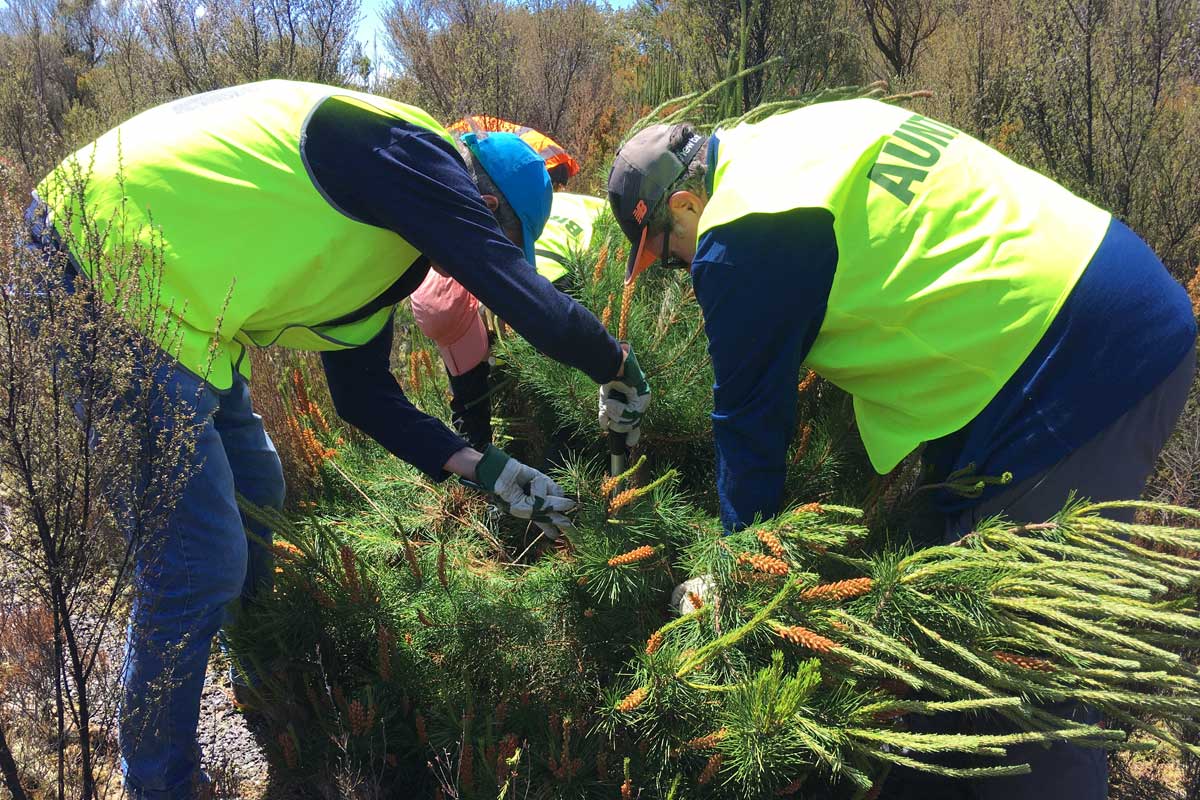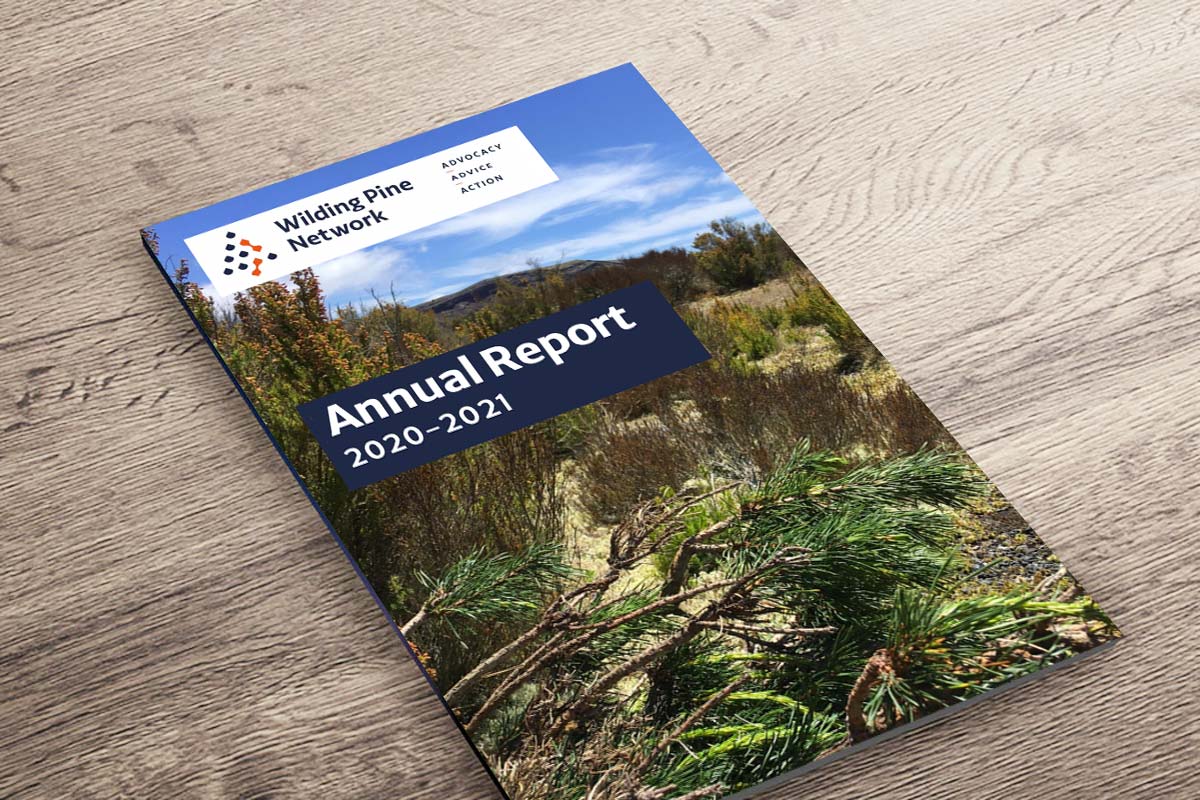The Hawkes Bay Wilding Pines Community Group is an entity specifically set up with DOC to manage wilding pines in The Lakes area of the Kaweka Forest Park in Hawkes Bay. These twin lakes are named Rotoroa and Rototuna. This is a particularly beautiful and sensitive part of the Kaweka Forest Park. It comprises 98 hectares that we hope to clear completely of wilding pines. The lakes and their surrounds host over 280 native plant species; including several that are uncommon and nationally significant. This is part of DOC’s plan to shield the Ruahine Ranges particularly, but also to control spread within the Kaweka’s, from wilding pine infestation.
Hawkes Bay Wilding Pines Community Group
Wilding Pine Network welcomes the PCE’s report on weeds in native ecosystems
The Wilding Pine Network endorses the PCE’s report on weeds titled “Space invaders: A review of how New Zealand manages weeds that threaten native ecosystems”. Weeds are a significant threat to Aotearoa’s native ecosystems and more action is needed to reduce the extent of weeds and prevent future invasions.
Wilding conifers have been fortunate to receive a boost in funding in recent years amounting to $137 million allocated from central government. This funding has enabled great progress to be made controlling wilding conifers. Between 2016-2021, the National Wilding Conifer Control Programme, with its partners, searched and controlled wilding infestations across over 2 million hectares of New Zealand. In 2020-21, the Programme controlled 817,000 hectares as well as surveyed 269,000 hectares to build knowledge of infestations and vulnerable landscapes.

Wilding conifers invading a rare geothermal ecosystem in the Waikato.
However, the funding for this management reduces substantially after this financial year, threatening the gains we’ve made to reduce the extent of wilding conifers. Ongoing removal of infestations and three-yearly cycles of maintenance control, to remove seedlings, are required to lock in the benefits and enable transition to local management. Under current funding beyond 2024, up to half of the area controlled by the Programme to date would receive no further control or maintenance work, resulting in reinfestation and further spread.
If investment is not boosted now, infestations not yet treated will continue to intensify, increasing control costs as well as impacts. Additionally, the Programme has built up a specialist and well-trained workforce, creating 1036 full-time and part-time jobs, particularly in the regions. If funding decreases, we will lose this workforce capability and people will lose jobs.
Richard Bowman, chair of the Wilding Pine network, says, “The PCE’s report highlights the value of acting early to control weeds as well as the need for a collective approach. Many community groups are involved in wilding control across the country, and they play a hugely important role in protecting our native ecosystems. However, every year we wait to control wildings in an area, the cost of control increases by 30%. We need sustained funding to intervene and protect our unique native ecosystems.”

Volunteers tackling a rogue wilding conifer.
The Wilding Pine Network is an independent advocacy and advisory group which supports the management of wilding conifer infestations in Aotearoa New Zealand via advocacy, advice and action. We provide advice to community groups involved in wilding management and share information to translate latest science into operations and policy.
For more information, please contact Rowan Sprague at rowan@nzwildingconifergroup.org / 027 833 6398.
Annual Report for 2020-21 now available
The Wilding Pine Network’s 2020-21 Annual Report is now available.

In this past year, the Wilding Pine Network (formerly the NZ Wilding Conifer Group) has continued to establish itself as an independent advocacy and advisory group.
Despite the uncertainty with Covid-19 and holding large events, we successfully ran our 2020 Wilding Conifer Conference in Rotorua. We had almost 140 people attend this three-day conference. Beyond the conference, we continued to build our information sharing capacity by starting a webinar series about latest wilding research and continuing to write and publish our quarterly newsletter.
Finally, as you may have noticed from our new logo and name on the front page, we have re-branded to be the Wilding Pine Network! Our official name is still the NZ Wilding Conifer Group, but we decided to update our trading name to be more accessible and friendly.
Bluff Hill Motupōhue Environmental Trust
Bluff Hill Motupohue Environment Trust (BHMET), established in 2008, is dedicated to the restoration and protection of the natural environment on and around Bluff Hill. We do this through pest and weed control, habitat restoration, species translocation and raising public awareness.
Arrowtown Choppers / Arrowtown Wilding Group
The Arrowtown Wilding Group and Arrowtown Choppers work to control and prevent the spread of wildings beyond Arrowtown. They hold many volunteer days open to the whole community.
Wilding Free Mackenzie
Wilding Free Mackenzie, formerly called the Mackenzie Wilding Trust, is a registered Charity, formed in 2016 as a vehicle to promote knowledge about the impact of wilding trees in the Mackenzie Basin and to work with stakeholders to implement a strategic approach to deal with the challenges wilding trees present.
Banks Peninsula Conservation Trust
The Banks Peninsula Conservation Trust advises landowners on wilding control techniques.
WELRA
WELRA tackles the wilding conifer problem in the Craigieburn area, the Castle Hill Basin, the Torlesse Range and surrounds. It was established in 2008 by landowners, managers, local residents, DOC, Environment Canterbury and the Canterbury Environmental Trust.
Amuri Range Wilding Tree Trust
The Amuri Range Wilding Tree Trust was established in 2019 and it brings together landowners in the Amuri Range to control wilding conifers.
South Marlborough Landscape Restoration Trust
The South Marlborough Landscape Restoration Trust is a community-led, collaborative group aiming to protect the landscape from wilding conifers. The Trust operates in South Marlborough, extending from the Waiau River in the north to the Clarence River and Molesworth Station in the south.
Project De-Vine Environmental Trust
Project De-Vine Environmental Trust aims to eradicate invasive plants and trees throughout Golden Bay and around the halo of Abel Tasman National Park.
Takaka Hill Biodiversity Group Trust
The Takaka Hill Biodiversity Group Trust works to restore and protect Takaka Hill ecosystems and indigenous biodiversity.
Abel Tasman Birdsong Trust / Project Janszoon
The Abel Tasman Birdsong Trust, through Project Janszoon, protects and enhances biodiversity to improve visitor experiences in Abel Tasman National Park, and this work includes a wilding pine control project.
Forest Lifeforce Restoration Trust
The Forest Lifeforce Restoration Trust was established in 2006 to provide direction and funding for the restoration of threatened species of fauna and flora, and to restore the ngahere mauri (forest lifeforce) in in Maungataniwha and Pohokura native forests within the Central North Island.
Palmy Pine Pulling Posse
The Palmy Pine Pulling Posse are a group of volunteers who control wildings in the Ruahine Forest Park.
Kuaotunu Peninsula Trust
The Kuaotunu Peninsula Trust lead wilding control in the Kuaotunu Peninsula.
Advocates for the Tongariro River
The Advocates for the Tongariro River are involved in wilding management along the Tongariro River.
Project Tongariro
Project Tongariro lead several wilding control projects around Taupō.
Ngati Tahu – Ngati Whaoa Runanga Trust
Ngati Tahu-Ngati Whaoa lead wilding control at Orakei-Korako, a unique and significant geothermal ecosystem.
Ruawahia 2B Trust
The Ruawahia 2B Trust are the land-based trust of Ngāti Rangithi and they look after and lead wilding control on Tarawera maunga.
Department Of Conservation
Your local DOC office can connect you with other initiatives in your area.
Weedbusters
Weedbusters is a weeds awareness and education programme protecting New Zealand’s environment from the increasing weed problem. There are more than 200 Weedbusters groups throughout New Zealand – use the Weedbusters website to find and contact your local group.
Mid Dome Wilding Trees Charitable Trust
The Mid Dome Trust controls wilding conifers on Mid Dome – an iconic area in the centre of Southland, but also a prime ‘take off’ site for wilding conifers spreading into the surrounding tussock and farmland.
Whakatipu Wilding Control Group
WCG controls wilding conifers in the Whakatipu Basin area to protect the remarkable landscape and biodiversity of this region. It was established in 2009.
Central Otago Wilding Conifer Control Group
The CWG was established in response to public concern about the spread of wilding conifers in the district. It coordinates and advises wilding management in Central Otago.
Ohau Conservation Trust
The Ohau Conservation Trust works to preserve the iconic tussock grasslands and native flora around Lake Ohau. They hold several restoration planting and wilding pine control volunteer days a year.
Marlborough Sounds Restoration Trust
The Marlborough Sounds Restoration Trust raises awareness about and controls wilding conifers in the Marlborough Sounds at the top of the South Island.